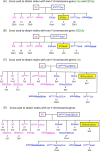Alterations of sex determination pathways in the genital ridges of males with limited Y chromosome genes†
- PMID: 30285093
- PMCID: PMC6437268
- DOI: 10.1093/biolre/ioy218
Alterations of sex determination pathways in the genital ridges of males with limited Y chromosome genes†
Abstract
We previously demonstrated that in the mouse only two Y chromosome genes are required for a male to produce an offspring with the help of assisted reproduction technologies (ART): testis determinant Sry and spermatogonial proliferation factor Eif2s3y. Subsequently, we have shown that the function of these genes can be replaced by transgenic overexpression of their homologs, autosomally encoded Sox9 and X-chromosome encoded Eif2s3x. Males with Y chromosome contribution limited to two (XEif2s3yOSry), one (XEif2s3yOSox9 and XOSry,Eif2s3x), and no genes (XOSox9,Eif2s3x) produced haploid germ cells and sired offspring after ART. However, despite successful assisted reproductive outcome, they had smaller testes and displayed abnormal development of the seminiferous epithelium and testicular interstitium. Here we explored whether these testicular defects originated from altered pro-testis and pro-ovary factor signaling in genital ridges at the time of sex determination. Timed pregnancies were generated to obtain transgenic XEif2s3yOSry, XEif2s3yOSox9, XOSry,Eif2s3x, XOSox9,Eif2s3x, and wild-type XX and XY fetuses at 12.5 days post coitum. Dissected genital ridges were assessed for their morphology and anatomy, and expression of pro-testis and pro-ovary transcripts. All transgenic males displayed incomplete masculinization of gonadal shape, impaired development of testicular cords and gonadal vasculature, and decreased expression of factors promoting male pathway. Fetal gonad masculinization was more effective when sex determination was driven by the Sry transgene, in the presence of Y chromosome genes, and to a lesser extent a double dosage of X genes. The study adds to the understanding of the role of Y chromosome genes and their homologs during sex determination.
Keywords: X chromosome; Y chromosome; sex determination; sex differentiation; testis.
© The Author(s) 2018. Published by Oxford University Press on behalf of Society for the Study of Reproduction.
Figures






Similar articles
-
Two genes substitute for the mouse Y chromosome for spermatogenesis and reproduction.Science. 2016 Jan 29;351(6272):514-6. doi: 10.1126/science.aad1795. Science. 2016. PMID: 26823431 Free PMC article.
-
Gonadal Identity in the Absence of Pro-Testis Factor SOX9 and Pro-Ovary Factor Beta-Catenin in Mice.Biol Reprod. 2015 Aug;93(2):35. doi: 10.1095/biolreprod.115.131276. Epub 2015 Jun 24. Biol Reprod. 2015. PMID: 26108792 Free PMC article.
-
Ontogenic and morphological study of gonadal formation in genetically-modified sex reversal XY(POS) mice.J Vet Med Sci. 2016 Jan;77(12):1587-98. doi: 10.1292/jvms.15-0292. Epub 2015 Jul 18. J Vet Med Sci. 2016. PMID: 26194606 Free PMC article.
-
Sex determination and sex reversal: genotype, phenotype, dogma and semantics.Hum Genet. 1992 Jul;89(5):467-79. doi: 10.1007/BF00219168. Hum Genet. 1992. PMID: 1634224 Review.
-
Characterising novel pathways in testis determination using mouse genetics.Sex Dev. 2014;8(5):199-207. doi: 10.1159/000358402. Epub 2014 Mar 13. Sex Dev. 2014. PMID: 24643063 Review.
Cited by
-
Eif2s3y Promotes the Proliferation of Spermatogonial Stem Cells by Activating ERK Signaling.Stem Cells Int. 2021 Jan 29;2021:6668658. doi: 10.1155/2021/6668658. eCollection 2021. Stem Cells Int. 2021. PMID: 33603791 Free PMC article.
References
-
- Gubbay J, Collignon J, Koopman P, Capel B, Economou A, Munsterberg A, Vivian N, Goodfellow P, Lovell-Badge R. A gene mapping to the sex-determining region of the mouse Y chromosome is a member of a novel family of embryonically expressed genes. Nature 1990; 346:245–250. - PubMed
-
- Sinclair AH, Berta P, Palmer MS, Hawkins JR, Griffiths BL, Smith MJ, Foster JW, Frischauf AM, Lovell-Badge R, Goodfellow PN. A gene from the human sex-determining region encodes a protein with homology to a conserved DNA-binding motif. Nature 1990; 346:240–244. - PubMed
-
- Hacker A, Capel B, Goodfellow P. Lovell-Badge R: Expression of Sry, the mouse sex determining gene. Development 1995; 121:1603–1614. - PubMed
-
- Jeske YW, Bowles J, Greenfield A, Koopman P. Expression of a linear Sry transcript in the mouse genital ridge. Nat Genet 1995; 10:480–482. - PubMed
-
- Koopman P, Munsterberg A, Capel B, Vivian N. Expression of a candidate sex-determining gene during mouse testis differentiation. Nature 1990; 348:450–452. - PubMed
Publication types
MeSH terms
Substances
Grants and funding
LinkOut - more resources
Full Text Sources
Molecular Biology Databases
Research Materials

